8 Best Jasper AI Alternatives: Top Chatbots to Power Your Business
Category: AI Tools

3 mins read
Chatbots have become an increasingly popular way for businesses to automate customer service, streamline workflows, and improve operational efficiency. Chatbots use artificial intelligence to understand questions and provide helpful responses without human intervention.
One of the leading chatbot platforms is Jasper AI. Jasper AI makes it easy to build sophisticated AI chatbots for your business. However, the cost of Jasper AI can be too high for some companies - their pricing typically starts at tens of thousands per year.
If you're looking to implement chatbots into your business processes but need a more affordable solution than Jasper AI, you have plenty of Jasper AI alternative options. There are alternative chatbot platforms that offer similar capabilities at lower price points, some even for free.
In this article, we'll explore 8 best Jasper AI alternatives. We'll discuss what each platform does and how it could benefit your business. Whether you're a small business owner or enterprise decision maker, you'll discover an option that fits your needs and budgets.
In this article:
Part 1. What is Jasper AI

Jasper AI is a popular chatbot platform that makes it easy to build and deploy AI chatbots for businesses. Jasper AI provides tools for creating chatbots that can handle customer service inquiries, process transactions, and streamline internal workflows.
Chatbots built on the Jasper AI platform use natural language processing and machine learning to understand questions and respond with accurate answers. Jasper AI offers pre-built templates and integrations so you can get started with minimal technical resources. Their visual editor lets you design engaging conversations without needing to know how to code.
Jasper AI is used by major companies like Air Canada, Vodafone, and Telus to power customer service chatbots on their websites and mobile apps. However, for smaller businesses, the cost of Jasper AI can be prohibitive. They offer custom pricing which typically starts in the tens of thousands of dollars per year for enterprise-level bots.
For those looking for more affordable alternatives, there are other chatbot options that provide similar features and benefits at a lower cost or even for free. In the next section, we'll explore the top Jasper AI alternatives so you can find a solution that fits your needs and budget.
Part 2. Why Go for Jasper AI Alternatives
While Jasper AI offers a robust set of features for building sophisticated chatbots, there are several reasons why you may want to consider alternative options:
- Cost - Jasper AI is an enterprise-level solution with custom pricing typically starting at tens of thousands per year. For small to mid-sized businesses, this cost can be prohibitive, especially if you're just getting started with chatbots. Alternative platforms provide more affordable options that fit a range of budgets. Some are even free to use.
- Flexibility - Jasper AI focuses primarily on customer service chatbots. Alternative platforms offer tools for building chatbots for internal workflows, ecommerce, education, and more. They give you more flexibility in how and where you can apply AI chatbot technology.
- Simplicity - While Jasper AI is a powerful platform, their tools can have a steep learning curve. Alternative options have more intuitive, easy-to-use interfaces so you can build, train, and launch chatbots without advanced technical skills. They simplify the process for non-developers.
- Open source - Unlike Jasper AI which is a paid proprietary platform, some alternatives offer open-source chatbot frameworks that developers can customize, expand on, and integrate with various systems. The open source options provide more control and flexibility for technical users.
- Scalability - For large deployments with complex integrations and compliance requirements, Jasper AI can be scalable. But for smaller uses, their minimum requirements may be more than you need. Alternative platforms have options for businesses of all sizes to scale chatbots as their needs evolve over time.
Part 3. 10 Best Jasper AI Alternatives
1. ChatArt
ChatArt is a creative AI chat and writing app available for iOS and Android devices. It offers a range of features that enable users to engage in AI-powered conversations and generate various types of written content for both personal and professional use.
Key Features:
- AI-Powered Real-time Chat: ChatArt allows users to engage in instant and interactive conversations with an AI chatbot. The chatbot is available 24/7, providing users with intelligent responses and answers to their queries.
- Theme-Based Content Creation: The app provides pre-designed scenarios for different aspects of life and work. Users can quickly generate text content in various formats, including chat scripts, marketing copy, article writing, work reports, personal emotion analysis, and more.
- Quick Experience and Free Trial: ChatArt offers users three free trial experiences per day, allowing them to explore the app's functionality without limitations. The app's interface includes preset topics from everyday life, ensuring easy and barrier-free access for users new to AI products.
Use Cases:
- Content Generation: ChatArt can be used for generating various types of written content, such as chat scripts for dialogues, marketing copy for advertisements, articles for blogs or websites, work reports for professional purposes, and personal emotion analysis for self-reflection.
- Writing Inspiration and Assistance: The app can serve as a source of inspiration and assistance for writers who need prompts, ideas, or help with overcoming writer's block. It can provide suggestions, generate content snippets, or assist in developing creative pieces.
- Communication and Personal Growth: ChatArt can be utilized as a tool for improving communication skills and self-expression. Users can engage in conversations with the AI chatbot to practice dialogue, receive feedback on their writing, or explore their emotions and thoughts through the app's analysis features.
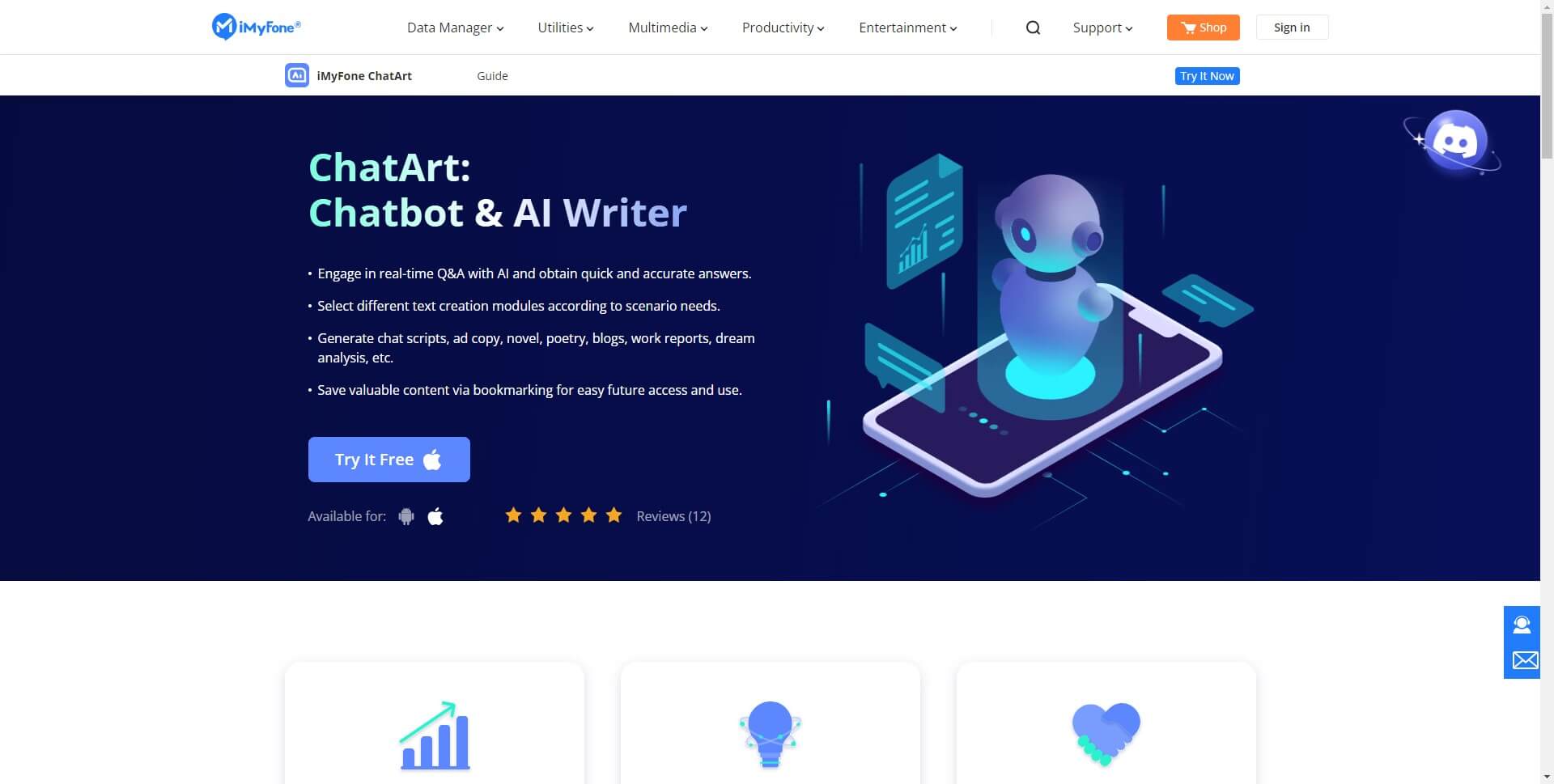
2. Google Cloud AI
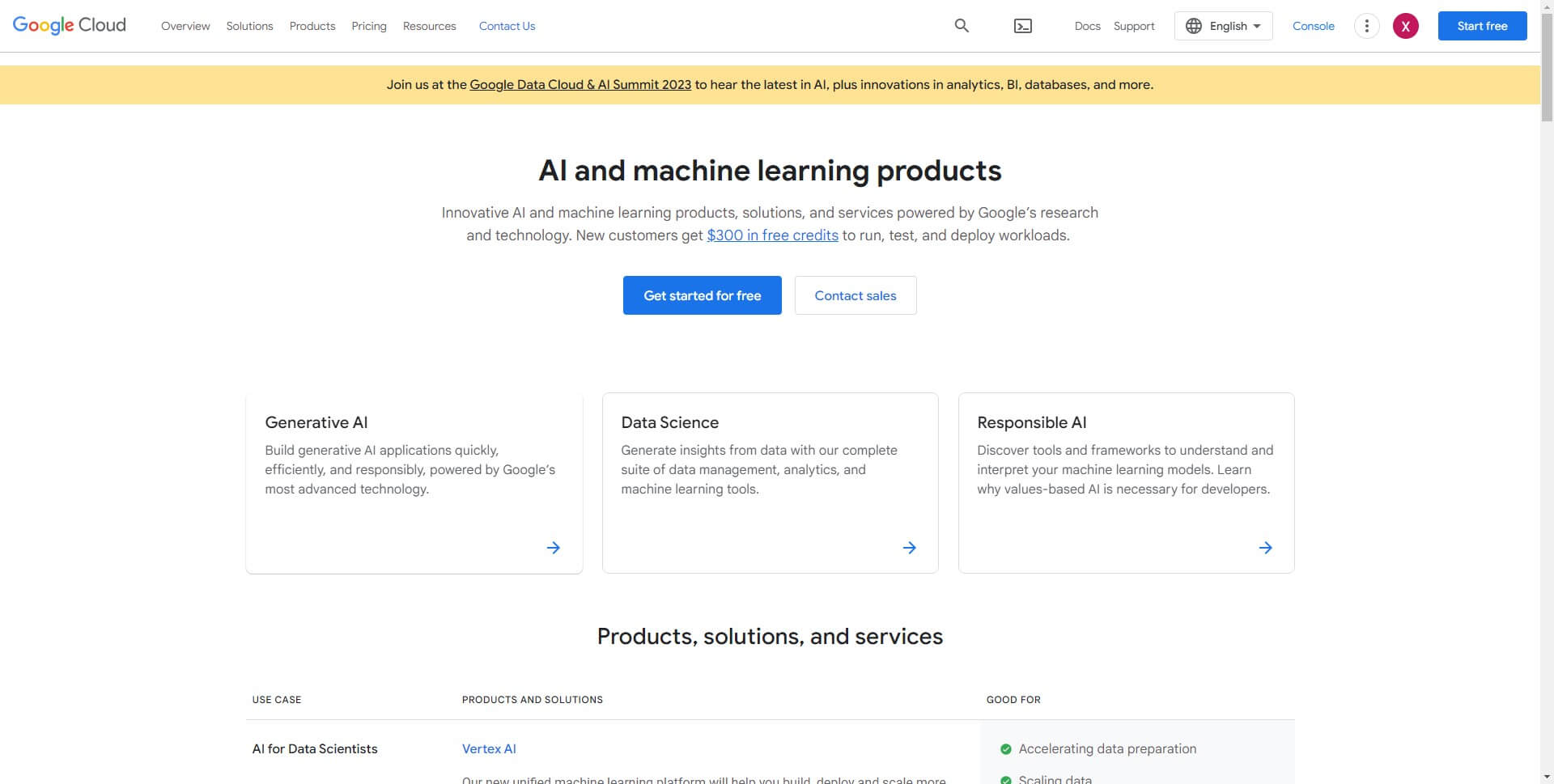
Google Cloud AI is a comprehensive suite of artificial intelligence tools and services provided by Google. It offers a range of powerful AI capabilities and frameworks to empower developers and businesses in building intelligent applications and leveraging machine learning technology.
Key features:
- Pre-trained Models and APIs: Google Cloud AI provides a collection of pre-trained models and APIs for various AI tasks, including computer vision, natural language processing, speech recognition, and translation. These models enable developers to integrate advanced AI capabilities into their applications with ease.
- AutoML and Customization: The platform offers AutoML, which allows users to build custom machine learning models without extensive coding or data science expertise. It also provides tools and resources for customizing and fine-tuning models to meet specific requirements.
- Scalability and Integration: Google Cloud AI leverages the scalable infrastructure of Google Cloud, allowing developers to train and deploy AI models at scale. It seamlessly integrates with other Google Cloud services, facilitating data management, processing, and deployment workflows.
Use Cases:
- Image and Video Analysis: Google Cloud AI can be used for image recognition, object detection, and video analysis. It has applications in industries such as e-commerce (product recognition and recommendation), healthcare (medical image analysis), and security (video surveillance).
- Natural Language Processing and Translation: The platform's language APIs enable developers to perform tasks like sentiment analysis, entity recognition, and language translation. Use cases include chatbots, customer support, content moderation, and multilingual applications.
- Recommendation Systems and Personalization: Google Cloud AI can power recommendation engines that analyze user behavior, preferences, and historical data to provide personalized recommendations. It finds applications in e-commerce, streaming services, content platforms, and personalized marketing campaigns.
3. Microsoft Azure Cognitive Services
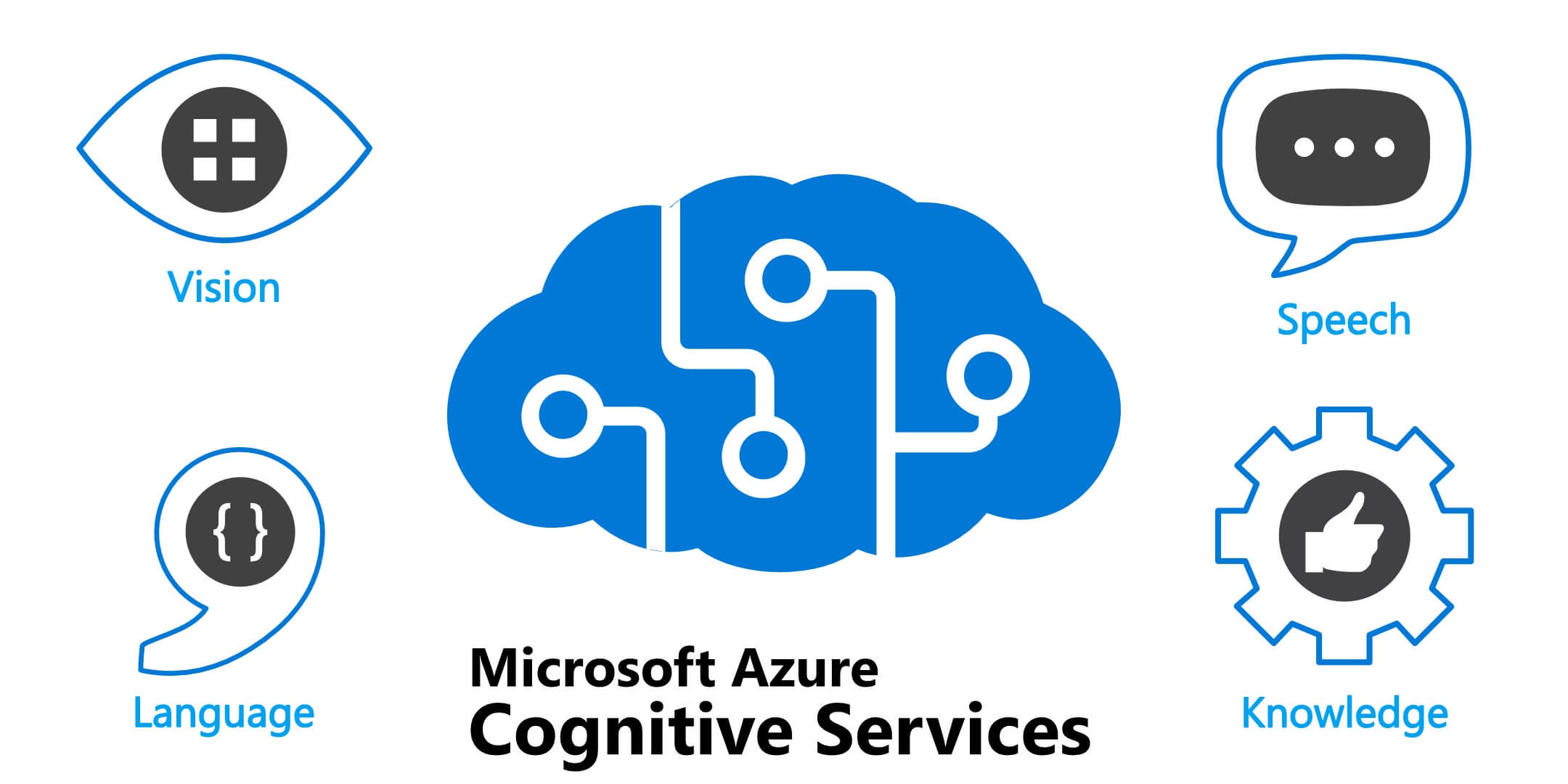
Microsoft Azure Cognitive Services is a suite of cloud-based APIs and services offered by Microsoft. These services are designed to enable developers to add various AI capabilities into their applications without the need for extensive knowledge or expertise in machine learning.
Key Features:
- Vision and Image Analysis: Azure Cognitive Services offers APIs for tasks such as image recognition, object detection, and facial recognition. These capabilities can be leveraged for applications like automated image tagging, content moderation, and visual search.
- Natural Language Processing: The platform provides APIs for language understanding, sentiment analysis, and text analytics. Developers can utilize these services to extract insights from text, perform language translation, and build chatbots or virtual assistants.
- Speech and Speaker Recognition: Azure Cognitive Services includes speech recognition and speaker recognition APIs, enabling developers to transcribe speech, identify speakers, and create voice-based authentication systems. These features are beneficial for applications like transcription services, voice-enabled authentication, and call center analytics.
Use Cases:
- Intelligent Virtual Assistants: Developers can utilize Azure Cognitive Services to build intelligent virtual assistants or chatbots that can understand and respond to user queries, provide personalized recommendations, and automate customer support.
- Sentiment Analysis and Social Media Monitoring: The natural language processing capabilities of Azure Cognitive Services make it suitable for sentiment analysis, enabling businesses to monitor social media sentiment, customer reviews, and feedback to gain insights and respond effectively.
- Smart Document Processing: Azure Cognitive Services can be used for intelligent document processing, including tasks like optical character recognition (OCR), form recognition, and data extraction. This is valuable for automating data entry, document classification, and content extraction from various types of documents.
4. Amazon Lex
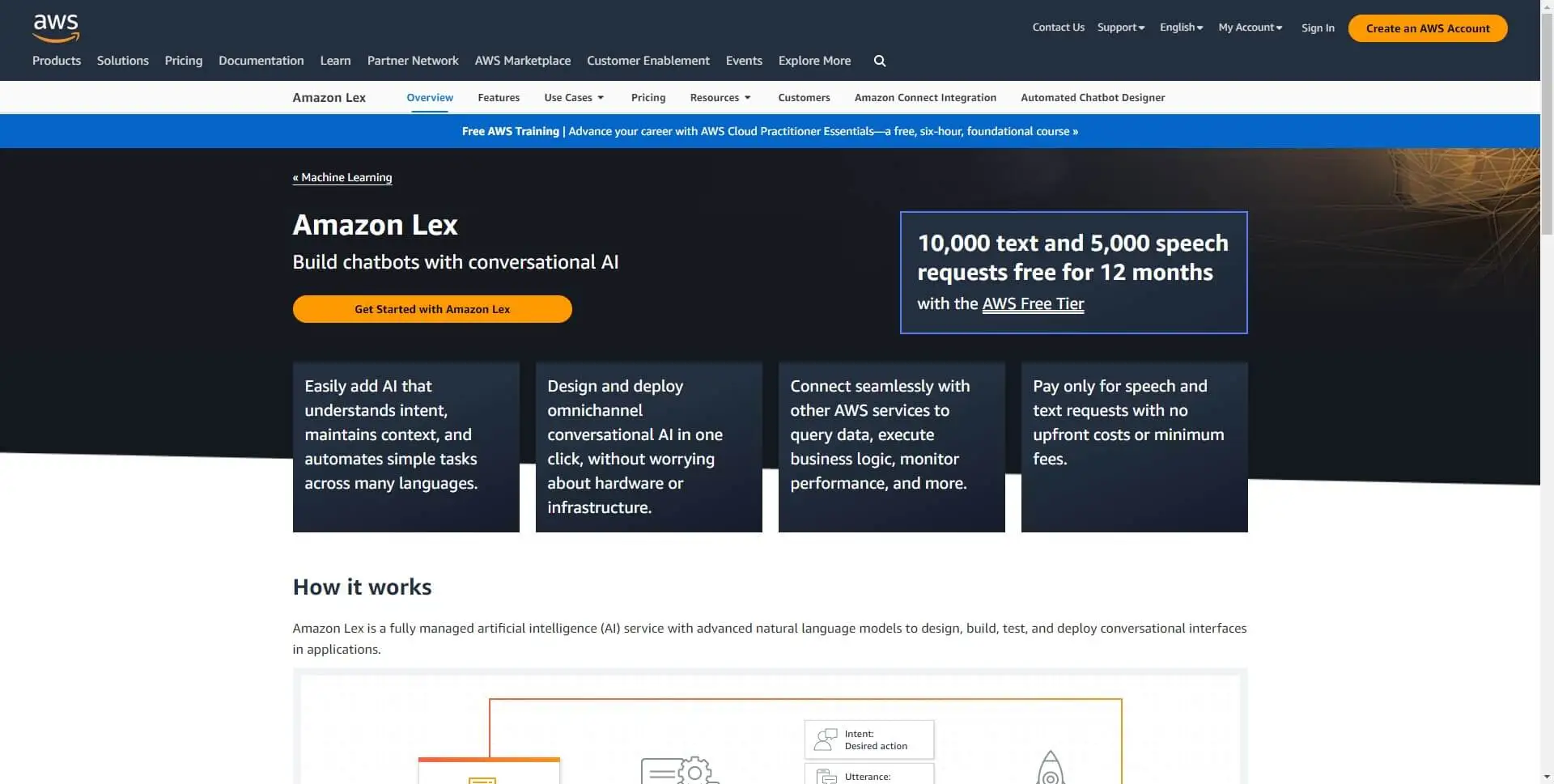
Amazon Lex is a service provided by Amazon Web Services (AWS) that enables developers to build conversational interfaces, commonly known as chatbots or virtual assistants. It utilizes the same technology and natural language understanding (NLU) capabilities that power Amazon Alexa.
Key Features:
- Natural Language Understanding: Amazon Lex employs advanced NLU algorithms to understand user input, including intents, entities, and dialogue context. It enables developers to create conversational experiences by processing and interpreting user queries.
- Dialog Management: The service provides tools for designing and managing dialog flows. Developers can define the conversation flow, prompt for information, handle errors, and dynamically generate responses based on user input.
- Integration with AWS Services: Amazon Lex seamlessly integrates with other AWS services, such as AWS Lambda, Amazon S3, and Amazon DynamoDB, enabling developers to extend the capabilities of their chatbots and integrate with various data sources and backend systems.
Use Cases:
- Customer Support: Amazon Lex can be used to build chatbots for customer support, allowing users to interact with the bot to get answers to common questions, troubleshoot issues, or request information.
- Voice-Enabled Applications: Developers can leverage Amazon Lex to create voice-enabled applications that enable users to interact with the application using natural language voice commands.
- Call Center Automation: Amazon Lex can automate call center workflows by handling initial customer inquiries, routing calls to the appropriate department, and assisting with basic support tasks, freeing up human agents to handle more complex issues.
5. IBM Watson
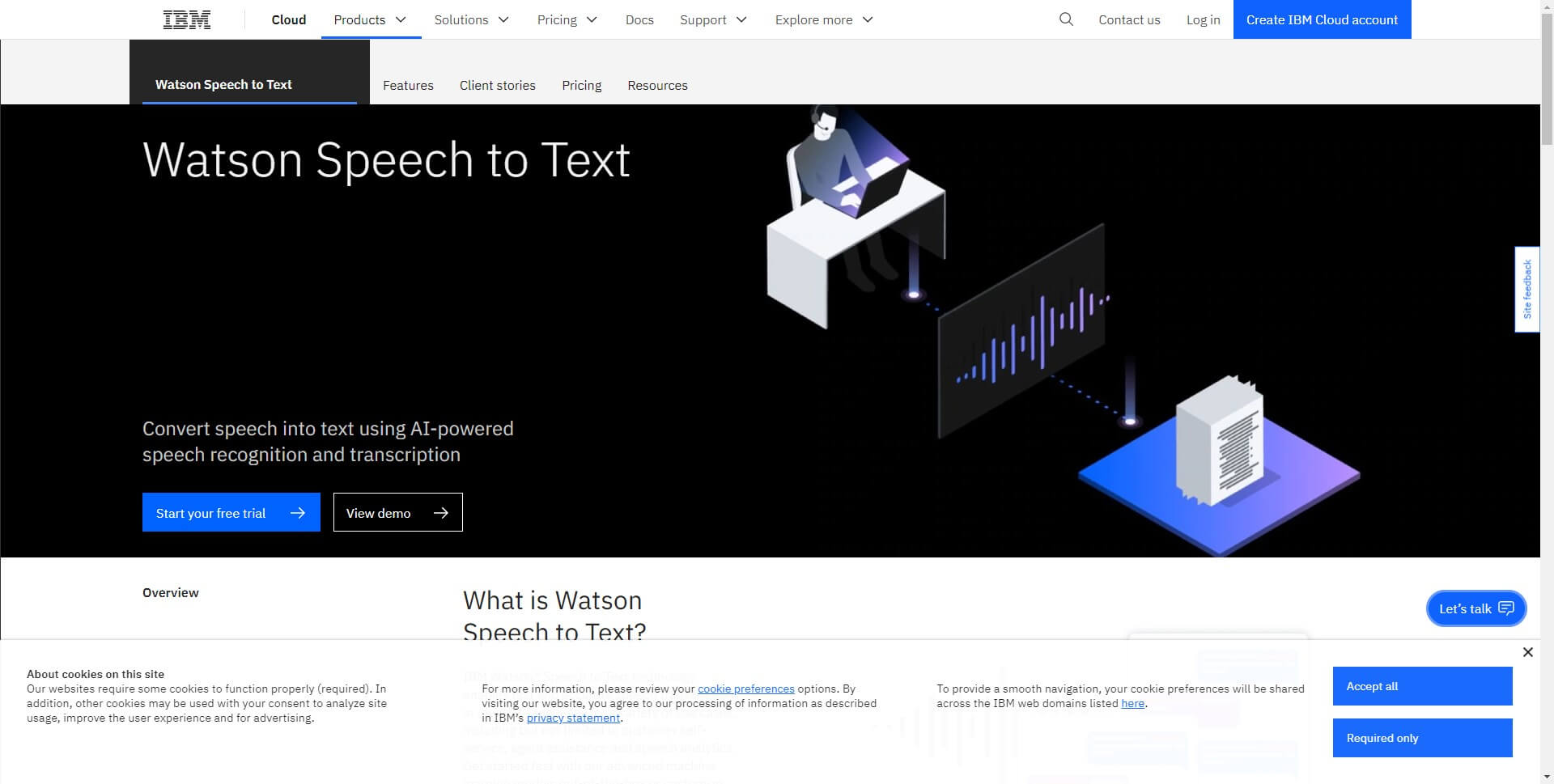
IBM Watson is an AI platform developed by IBM that offers a range of cognitive technologies and services. It leverages natural language processing, machine learning, and other AI techniques to provide advanced analytics, language understanding, and decision-making capabilities.
Key Features:
- Natural Language Processing: IBM Watson excels in language understanding and processing tasks, including sentiment analysis, language translation, entity recognition, and question answering.
- Machine Learning Integration: The platform seamlessly integrates with popular machine learning frameworks, allowing developers to train and deploy custom models using their own data.
- Knowledge Graphs and Reasoning: Watson incorporates knowledge graphs and reasoning capabilities to understand complex relationships between entities and derive insights from vast amounts of structured and unstructured data.
Use Cases:
- Healthcare and Life Sciences: IBM Watson is extensively used in healthcare for medical research, diagnosis assistance, and personalized treatment recommendations. It can analyze medical records, research papers, and patient data to aid in clinical decision-making.
- Customer Support and Chatbots: Watson's natural language processing capabilities make it well-suited for developing chatbots and virtual assistants. It can understand user queries, provide personalized responses, and assist with customer support inquiries.
- Data Analytics and Insights: With its advanced analytics capabilities, Watson can process large datasets, identify patterns, and generate actionable insights. This is valuable in fields such as finance, marketing, and supply chain management.
6. Hugging Face Transformers
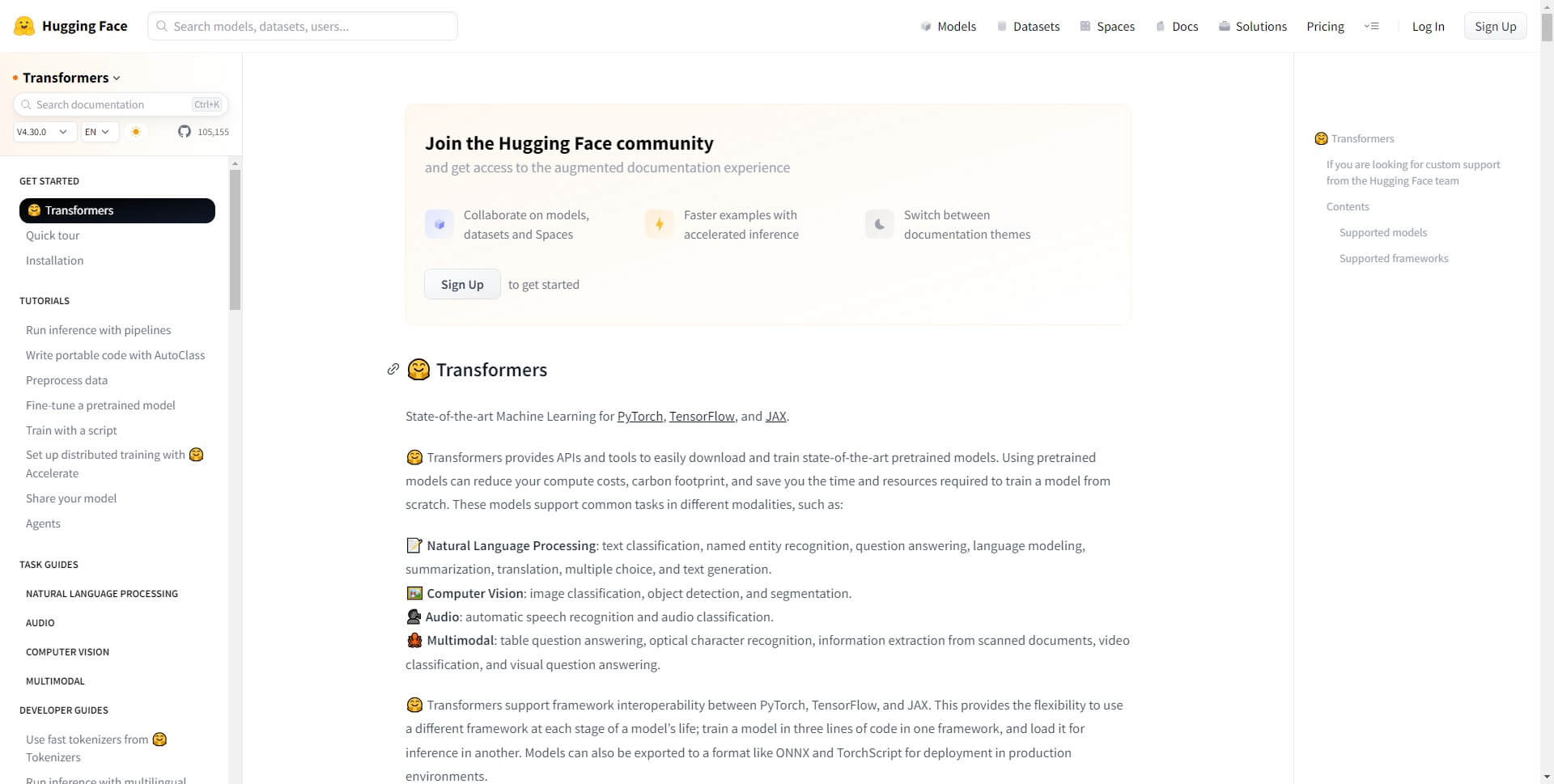
Hugging Face Transformers is an open-source library and platform that focuses on natural language processing (NLP) tasks. It provides a collection of pre-trained models, tools, and utilities to facilitate the development of state-of-the-art NLP applications.
Key Features:
- Pre-trained Models: Hugging Face Transformers offers a vast selection of pre-trained models for a wide range of NLP tasks, including text classification, named entity recognition, question answering, and language translation.
- Model Fine-tuning: Developers can easily fine-tune pre-trained models using their own domain-specific data, allowing for customization and improved performance on specific tasks.
- Community and Collaboration: Hugging Face has a thriving community of developers and researchers who actively contribute to the library. This fosters collaboration, knowledge sharing, and the continuous improvement of NLP models and techniques.
Use Cases:
- Text Classification and Sentiment Analysis: Hugging Face Transformers can be utilized to classify text into different categories or determine the sentiment expressed in a given text. This is useful in applications such as content moderation, social media analysis, and customer feedback processing.
- Question Answering and Chatbots: The library's pre-trained models enable the development of chatbots and question-answering systems that can understand user queries and provide relevant responses. This is applicable in customer support, information retrieval, and virtual assistant applications.
- Language Translation and Summarization: Hugging Face Transformers supports language translation tasks, allowing developers to build applications that can translate text between different languages. Additionally, it can be used for automatic text summarization, condensing large documents into shorter, more concise summaries.
7. Wit.ai
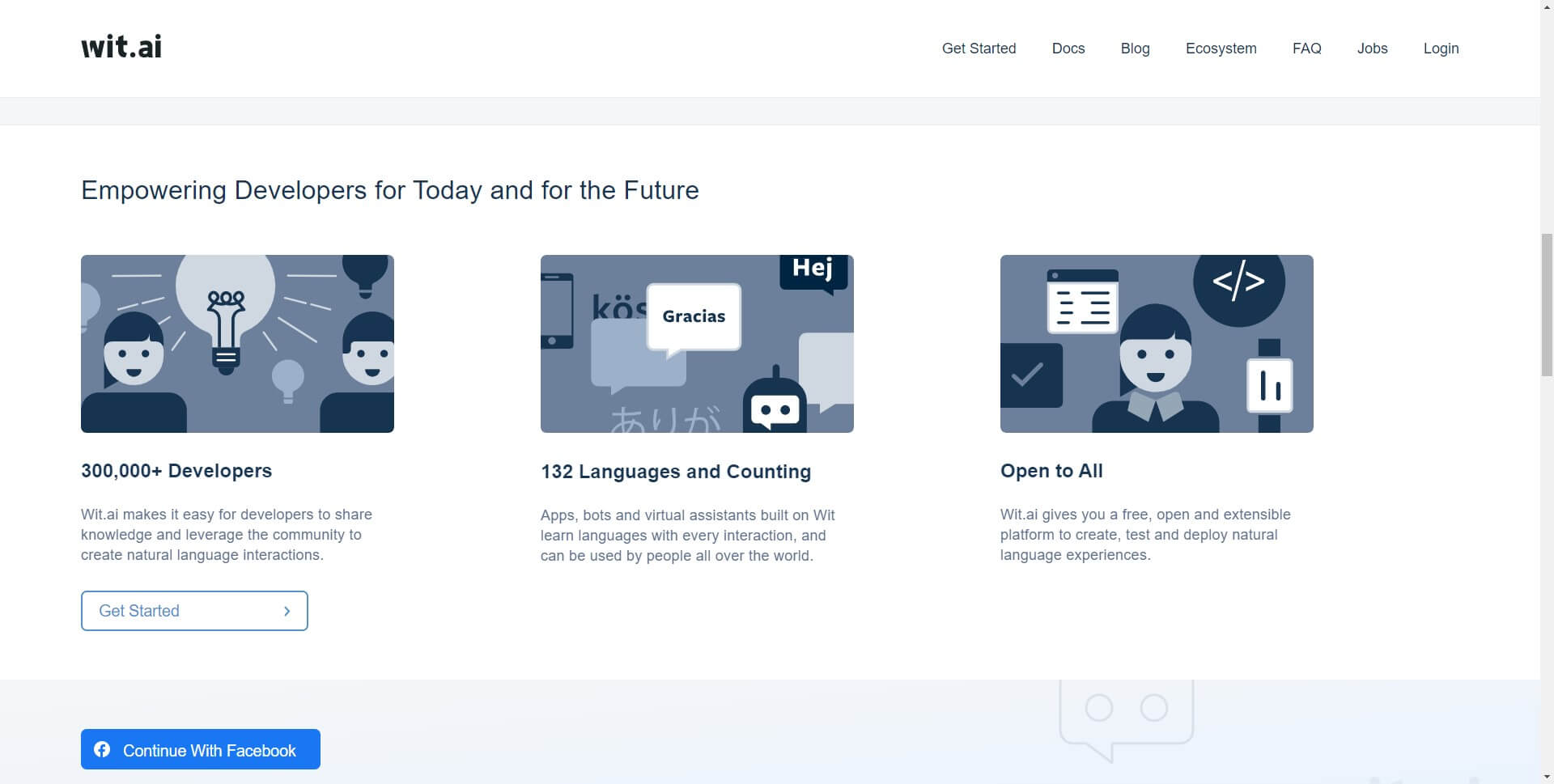
Wit.ai is a natural language processing (NLP) platform that enables developers to build applications and chatbots with conversational capabilities. It provides tools and services for processing and understanding user input in natural language.
Key Features:
- Intent Recognition: Wit.ai offers powerful intent recognition capabilities, allowing developers to train models to understand the intentions behind user queries or commands. This enables accurate and context-aware responses.
- Entity Extraction: The platform supports entity extraction, which involves identifying and extracting specific pieces of information from user input. This helps in understanding key details such as dates, locations, names, or any custom-defined entities.
- Dialog Management: Wit.ai includes features for managing dialog flows, enabling developers to create interactive conversational experiences. It allows the design of multi-turn conversations, context tracking, and maintaining state during conversations.
Use Cases:
- Chatbots and Virtual Assistants: Wit.ai is commonly used to develop chatbots and virtual assistants for various platforms such as websites, messaging applications, and voice-based interfaces. It helps in understanding user queries and generating appropriate responses.
- Voice-Activated Applications: With Wit.ai, developers can build voice-activated applications that can understand and respond to spoken commands. This is beneficial for voice-controlled devices, smart home automation, and hands-free interactions.
- Language Understanding in Applications: Wit.ai's NLP capabilities make it suitable for enhancing language understanding in applications. It can be integrated into customer support systems, content analysis tools, and any application that requires parsing and understanding natural language input.
8. Rasa
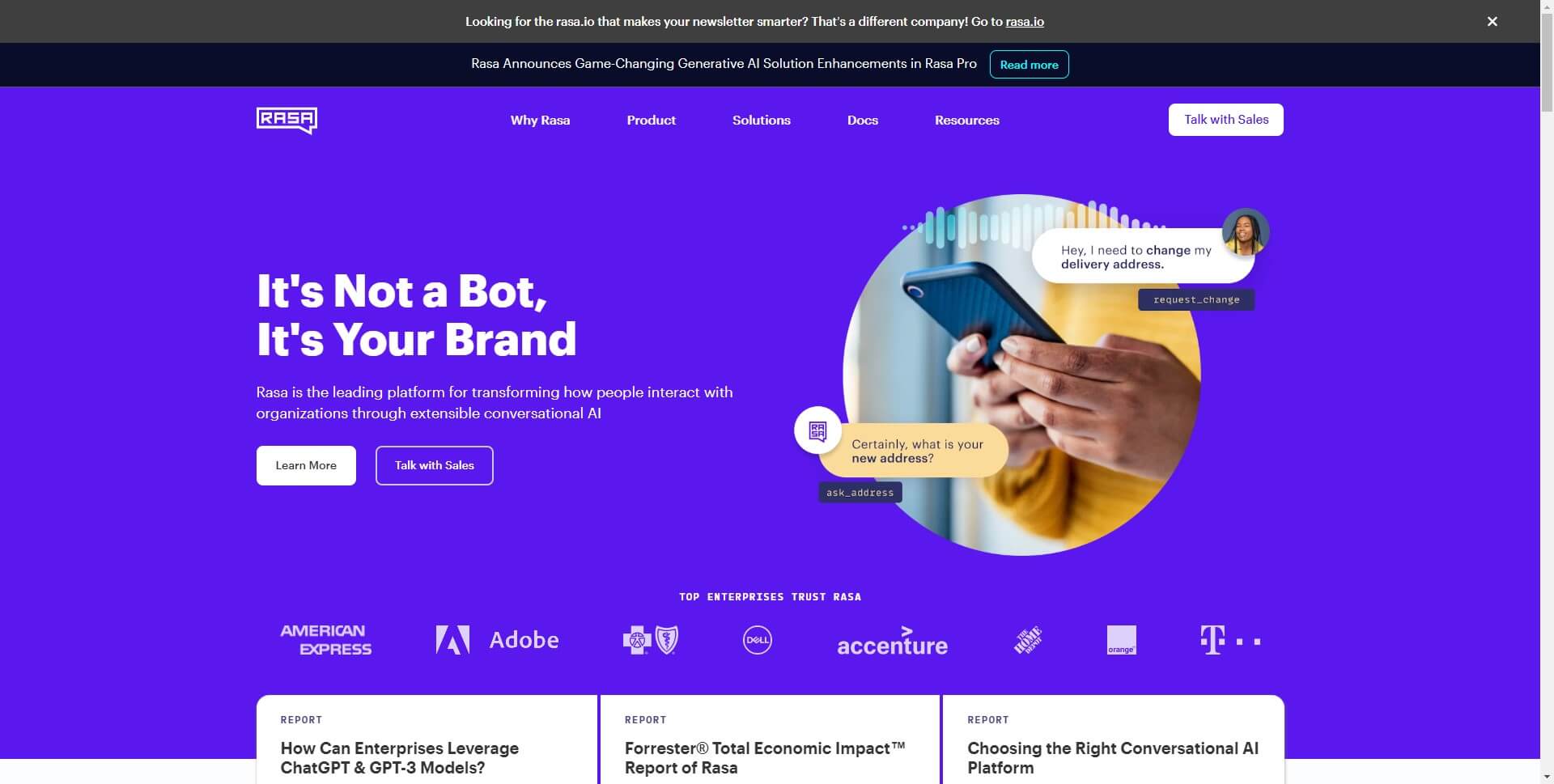
Rasa is an open-source framework for building AI-powered chatbots and conversational agents. It provides a set of tools and libraries that enable developers to create sophisticated and customizable conversational experiences.
Key Features:
- Intent Recognition and Entity Extraction: Rasa offers robust intent recognition and entity extraction capabilities, allowing developers to train models to understand user intents and extract relevant information. This helps in accurately interpreting user input.
- Contextual Conversations: Rasa supports contextual conversations, enabling developers to design chatbots that remember previous interactions and maintain the context throughout the conversation. This helps in creating more natural and engaging conversational experiences.
- Customization and Integration: Rasa provides flexibility for developers to customize and extend its functionality to suit specific use cases. It can be integrated with existing systems and data sources, enabling seamless interactions with backend services and databases.
Use Cases:
- Customer Support Chatbots: Rasa can be used to build chatbots that assist with customer support by understanding user queries, providing relevant information, and handling common support requests. This helps in improving response times and overall customer satisfaction.
- Virtual Agents for Applications: Rasa enables the development of virtual agents that interact with users within specific applications or services. These agents can understand user commands, execute actions, and provide guidance or recommendations.
- Voice and Text-based Conversational Interfaces: Rasa can be utilized to create conversational interfaces for voice-controlled devices, messaging applications, or voice assistants. It enables natural language understanding and context management in these interfaces, enhancing the user experience and interaction with the system.
Conclusion
In conclusion, while Jasper AI is a popular and powerful chatbot platform, its high cost may not be feasible for all businesses. Fortunately, there are several affordable Jasper AI alternatives available that provide similar features and benefits. The article discussed 8 top Jasper AI alternatives, including ChatArt, Google Cloud AI, Microsoft Azure Cognitive Services, Amazon Lex, IBM Watson, Hugging Face Transformers, Wit.ai, and Rasa.
These alternative platforms offer various advantages such as lower costs, greater flexibility, simplicity, open-source options, and scalability. Each platform has its unique features and use cases, making it possible for businesses of all sizes and industries to find a suitable solution for their needs and budgets.
Ultimately, the choice of the best Jasper AI alternative depends on your specific requirements and preferences. You’ll find a chatbot platform that fits their needs and empowers them to harness the benefits of AI without breaking the bank in this article.




















